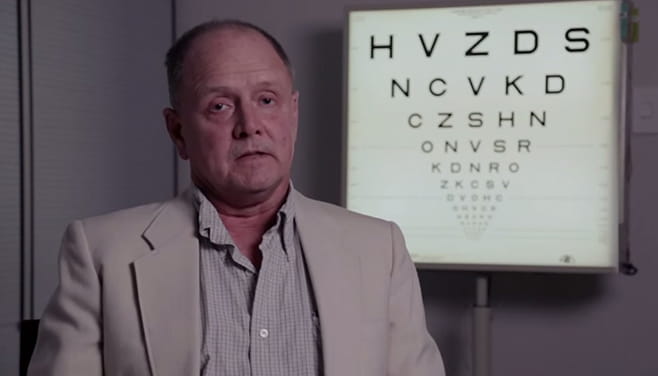Eye Cancer Treatment
At Houston Methodist Cancer Center, our highly skilled ocular specialists offer the most cutting-edge eye cancer treatments available. We are committed to ensuring you receive expert care in a compassionate, collaborative and innovative environment.
Personalized Treatment Plans for Eye Cancer
Our team, including radiation oncologists, oncologists, radiation physicists and pathologists, works together to formulate a treatment plan unique to each patient.
We use an innovative brachytherapy approach to precisely deliver radiation to a patient's eye tumor using an implanted disc customized for the specific size, shape and contour of the tumor. Using real-time ultrasound, we ensure the disc is centered directly over the tumor, minimizing radiation damage to healthy eye parts while maximizing tumor treatment. Our specialists have performed hundreds of these procedures.
Advanced Treatment for a Rare Eye Cancer: Darrell's Story

A friend’s cataract surgery reminded Darrell that he needed an eye exam. His decision to have an eye exam was a wise one, because the retinal specialist in Alaska detected cancer and sent him to Houston Methodist to receive advanced care for uveal melanoma, a rare eye cancer. Darrell was fortunate to find the expertise he needed for his rare form of cancer at Houston Methodist.
Eye Cancer Treatment Optionsat Houston Methodist
Eye cancer treatment options vary depending on your specific eye tumor. At Houston Methodist, your care team will design the best treatment plan for your specific diagnosis and unique lifestyle needs.
Biopsy of Eye Tumors Helps Guide Eye Cancer Treatment
Fine-needle aspiration biopsies enable our team to confirm uveal melanoma, perform genomic analysis of tumor cells and perform genomic research. Genomic analysis helps determine the best course of treatment as well as whether there's a risk of the cancer spreading from the eye to other parts of the body.
Patients with relatively small tumors and/or tumors near critical eye structures (such as the optic nerve or macula) routinely undergo biopsies without complications because of our team’s extensive surgical experience.
Plaque Surgery (Brachytherapy) for Eye Cancer
Radiation beads, known as seeds, are chosen and designed for each patient based on eye tumor size, shape and configuration. The seeds are placed in a gold-backed, bottle-cap-shaped implant that helps protect the healthy surrounding tissues. The radiation patch is inserted onto the eye’s outside surface during a surgical procedure, where it remains while the radiation treats the tumor.
After several days, the patch is removed during a second surgery. The radiation kills the tumor cells while preserving vision. The entire treatment occurs on an outpatient basis.
Enucleation for Eye Cancer
Enucleation, the oldest form of uveal melanoma treatment, is permanent surgical removal of the diseased eye. The procedure leaves eye muscles and the conjunctiva (the skin of the eye) and eyelids intact, however. A sphere-shaped implant is inserted into the orbital cavity to fill the space, and the eye muscles are attached to the implant to create movement.
After the tissues heal, you are referred to an ocularist, who fits you for an ocular prosthesis painted to match your other eye. The prosthesis does not move like a normal eye, but it looks natural. The treatment is fast, definitive and requires limited ophthalmic follow up. However, vision in the affected eye is lost.
Clinical Trials for Eye Cancer
Our experts conduct clinical research on nearly every type of eye cancer. We also provide access to clinical trials offering potentially promising treatments for uveal melanoma, as well as smaller tumors near critical eye structures, such as the macula and optic nerve. Some of these treatments may minimize vision loss for more advanced eye cancers.
